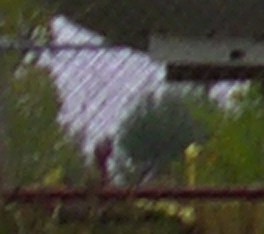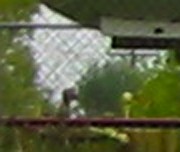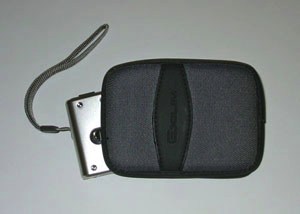Casio EX-S100 digital camera
Delightfully cool little camera
The best way I can explain what happened to me
when I first
read about Casio's Exilim EX-S100 camera is to paraphrase Penny Arcade's guest columnist
Storm
Shadow and say that I missed my saving throw against cool gadgets.
It's not surprising that I missed; the camera is small and shiny and sleek and
has a really big LCD display. From the front, it's barely bigger than a credit
card and it's no thicker than a slice of toast. And it records 3.2m pixels. How
could any self-respecting gadget geek not be
entranced?
I did read a couple of reviews (1, 2) first, and if both of them had said "Turned our reviewer into a bug-eyed zombie" I probably would have thought twice about buying one. But neither did. And as it turns out, I'm very happy with the camera. I won't bother to repeat what's in those reviews, but there are a few things I think are worth mentioning.
Casio had to make a compromise or two in making the camera as small as they have. For one, there's no viewfinder. But I find that doesn't bother me. The LCD is big and comfortable to use and I'm sure that I'll eventually stop putting the camera up to my eye before remembering that that doesn't work.
The most significant compromises seem to be in the lens and the size of the image sensor. It seems that resolution suffers a bit. I bought the EX-S100 to replace my mildly-antique Canon Elph PowerShot S200, so that's what I have to compare it to. Here's a magnified detail from a shot with the Casio at its highest resolution:

And here's the same detail from the same scene shot a moment later with the Canon:

The Casio's image is bigger because it records more dots, but there's no more detail. (The Casio's color is a little more accurate.)
To go with detail that's not better than a 2.0m-dot camera, there's some image noise. The EX-S100's sensor is 1/3.2 (or in sane units about 4.5 x 3.4 mm) vs. 1/2.7 (5.3 x 4.0 mm) for the Canon. The Casio squeezes 3.2m pixels into that area while the Canon has only 2.0m on its larger sensor. That means that the individual photosites on the Casio are going to be considerably smaller. If I'm counting right, the Casio's dots are slightly less than half the size of the Canon's. That seems to cause a little trouble because the camera has to turn up the gain a fair amount in low-light situations. When the camera decides that it needs ISO 400 sensitivity, there's visible noise in the picture. Here are enlarged details of a shot of a blank wall shot at ISO 100, 200, and 400:



(The color varies a bit because I didn't bother to fiddle the white balance.) Noise is visible in the middle one, but it's pretty pronounced in the last. In practice, images taken at ISO 200 don't look noisy. At ISO 400, they do. Happily, it seems that the camera doesn't think it needs ISO 400 very often.
I think that the EX-S100 may be able to record a slightly larger range of brightnesses than the S200 can. But if that's true, the difference is marginal.
On the good side, Casio uses the big, clear LCD to provide a the user interface that's very clean. Indeed, it's as good as I've seen on a digital camera. And that's matched by control buttons that work nicely and feel good. And in addition, there's one feature that I haven't seen before and which I'm very glad to have: You can specify which settings revert to default after power-off and which are remembered. I like that because I think it's rude to take flash pictures in most public places. My Canon would enable automatic flash each time I switched it on. I'm sure that most people like that; they won't miss a photo if the light is dim. For me, it meant that I had to remember to switch the flash off if I didn't want it each time I switched the camera on. With the Casio, I can tell it to remember the last flash setting.
You use a cradle both to import photos and to charge the camera. You can set the camera to look like a USB mass-storage device when it's in the cradle and so it works just fine under OS X and ought to work equally wall under any sane operating system. The cradle and its wall-plug transformer aren't big or heavy, but people who want to travel as light as possible can buy a travel charger for the battery and an SD card-to-USB dongle. Interestingly, the connector that mates with the camera when it's in the cradle looks a lot like a USB Mini-B plug. I have one of those cables, but since nothing I've found in the documentation or elsewhere mentions USB Mini-B cables, I think I'll let someone else try plugging in the camera that way first. (If you do, I'd be glad to know what happens.)
The camera doesn't fit into Casio's "EXCASE3" very exactly:

Happily, the cooler Japanese cases seem to be available here in the US. I plan to order one soon.
In the end, I like the camera a lot. I could wish that there weren't any compromises involved in its engineering. And I could also wish for a pony. It works perceptibly better than my S200 and it's half the size of that small camera. That's quite good enough for me.
Update October 29, 2004:
My Japanese-market case arrived today and it's much nicer than the American-market one. I ordered the soft case in "ebony". The case that arrived is an attractive shade of very dark brown. The packaging is marked "cioccolato" and "chocoraato". The leather is pleasantly soft and it fits the camera snugly. Even in the case, the camera fits tidily in a shirt pocket. The case's flap is secured with the sort of magnetic disks you've almost certainly seen before. The camera's power switch is designed in such a way that it seems unlikely that it will get switched on accidentally. The case doesn't have a belt-loop or clip; it's suitable for protecting the camera in a pocket or a bag. That suits me just fine because I don't like carrying things on my belt. You may have a different opinion.
I did read a couple of reviews (1, 2) first, and if both of them had said "Turned our reviewer into a bug-eyed zombie" I probably would have thought twice about buying one. But neither did. And as it turns out, I'm very happy with the camera. I won't bother to repeat what's in those reviews, but there are a few things I think are worth mentioning.
Casio had to make a compromise or two in making the camera as small as they have. For one, there's no viewfinder. But I find that doesn't bother me. The LCD is big and comfortable to use and I'm sure that I'll eventually stop putting the camera up to my eye before remembering that that doesn't work.
The most significant compromises seem to be in the lens and the size of the image sensor. It seems that resolution suffers a bit. I bought the EX-S100 to replace my mildly-antique Canon Elph PowerShot S200, so that's what I have to compare it to. Here's a magnified detail from a shot with the Casio at its highest resolution:

And here's the same detail from the same scene shot a moment later with the Canon:

The Casio's image is bigger because it records more dots, but there's no more detail. (The Casio's color is a little more accurate.)
To go with detail that's not better than a 2.0m-dot camera, there's some image noise. The EX-S100's sensor is 1/3.2 (or in sane units about 4.5 x 3.4 mm) vs. 1/2.7 (5.3 x 4.0 mm) for the Canon. The Casio squeezes 3.2m pixels into that area while the Canon has only 2.0m on its larger sensor. That means that the individual photosites on the Casio are going to be considerably smaller. If I'm counting right, the Casio's dots are slightly less than half the size of the Canon's. That seems to cause a little trouble because the camera has to turn up the gain a fair amount in low-light situations. When the camera decides that it needs ISO 400 sensitivity, there's visible noise in the picture. Here are enlarged details of a shot of a blank wall shot at ISO 100, 200, and 400:



(The color varies a bit because I didn't bother to fiddle the white balance.) Noise is visible in the middle one, but it's pretty pronounced in the last. In practice, images taken at ISO 200 don't look noisy. At ISO 400, they do. Happily, it seems that the camera doesn't think it needs ISO 400 very often.
I think that the EX-S100 may be able to record a slightly larger range of brightnesses than the S200 can. But if that's true, the difference is marginal.
On the good side, Casio uses the big, clear LCD to provide a the user interface that's very clean. Indeed, it's as good as I've seen on a digital camera. And that's matched by control buttons that work nicely and feel good. And in addition, there's one feature that I haven't seen before and which I'm very glad to have: You can specify which settings revert to default after power-off and which are remembered. I like that because I think it's rude to take flash pictures in most public places. My Canon would enable automatic flash each time I switched it on. I'm sure that most people like that; they won't miss a photo if the light is dim. For me, it meant that I had to remember to switch the flash off if I didn't want it each time I switched the camera on. With the Casio, I can tell it to remember the last flash setting.
You use a cradle both to import photos and to charge the camera. You can set the camera to look like a USB mass-storage device when it's in the cradle and so it works just fine under OS X and ought to work equally wall under any sane operating system. The cradle and its wall-plug transformer aren't big or heavy, but people who want to travel as light as possible can buy a travel charger for the battery and an SD card-to-USB dongle. Interestingly, the connector that mates with the camera when it's in the cradle looks a lot like a USB Mini-B plug. I have one of those cables, but since nothing I've found in the documentation or elsewhere mentions USB Mini-B cables, I think I'll let someone else try plugging in the camera that way first. (If you do, I'd be glad to know what happens.)
The camera doesn't fit into Casio's "EXCASE3" very exactly:

Happily, the cooler Japanese cases seem to be available here in the US. I plan to order one soon.
In the end, I like the camera a lot. I could wish that there weren't any compromises involved in its engineering. And I could also wish for a pony. It works perceptibly better than my S200 and it's half the size of that small camera. That's quite good enough for me.
Update October 29, 2004:
My Japanese-market case arrived today and it's much nicer than the American-market one. I ordered the soft case in "ebony". The case that arrived is an attractive shade of very dark brown. The packaging is marked "cioccolato" and "chocoraato". The leather is pleasantly soft and it fits the camera snugly. Even in the case, the camera fits tidily in a shirt pocket. The case's flap is secured with the sort of magnetic disks you've almost certainly seen before. The camera's power switch is designed in such a way that it seems unlikely that it will get switched on accidentally. The case doesn't have a belt-loop or clip; it's suitable for protecting the camera in a pocket or a bag. That suits me just fine because I don't like carrying things on my belt. You may have a different opinion.
Posted: Tue - October 26, 2004 at 04:27 Main Category:
Quick Links
Calendar
| Sun | Mon | Tue | Wed | Thu | Fri | Sat |
Categories
Archives
XML/RSS Feed
Me
Statistics
Total entries in this blog:
Total entries in this category:
Published On: Nov 03, 2004 09:04
Total entries in this category:
Published On: Nov 03, 2004 09:04